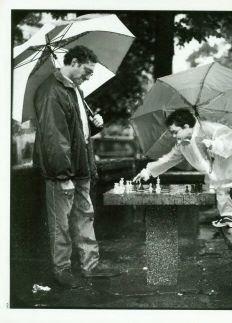
The Power of Criss-Crossing Bishops
No reaction. A few suppressed smiles.
Thomas: What were you planning for today, Professor?
Professor: I thought we'd talk about the two bishops.
Lucian: How they're better than two knights?
Rachel: Or better than bishop and knight?
Idris: They're often better, but not always.
Professor: I was thinking more in terms of how they can snare other minor pieces or...
Lucian: Mate?
Professor: Perhaps.
Hale: Can we see what you mean?
Professor: Certainly. Consider our first diagram.
Question 1: How can White trap Black's knight?
It took only a minute, but the lines were fairly clear, and that made the group eager for more chess.
Rachel: Wow! The knight really does get trapped.
Lucian: A deadly skewer.
Hale: I love the criss-cross action of the bishops.
Professor: I presume you'd like to see more of that, so here's the next problem.
Question 2: How can White trap Black's knight?
Thomas: These first two problems are not unrelated.
Lucian: One stresses the skewer, the other the pin.
Zephyr: But both had criss-crossing bishops.
Hale: Against a lone knight.
Professor: In the next problem, let's add a pawn, just to make it interesting.
Zephyr: Interesting? Allow us to be the judges of that.

Question 3: Can White force a win?
The wunderkinder had no trouble solving this one. Their banter suggested a desire for more.
Ryan: Those weren't exactly criss-crossing bishops.
Hale: Not in all the lines.
Thomas: In the main variation they were more like aligned bishops.
Lucian: Yeah, they wound up guarding two consecutive diagonals.
Professor: Enough of bishops vs. knights. Let's see how bishops fare against their counterparts.
Rachel: Counterparts?
Zephyr: He means other bishops, but he insists on talking like a pedantic professor.
Question 4: Can White force a win?
The kids had no trouble with this problem either. That meant they continued to be boisterously rambunctious.

Ryan: Do you have any more of these clerical puzzles, Professor?
Zephyr: Clerical? You mean like sacerdotal?
Ryan: No, I was speaking metaphorically.
Hale: You mean like hieratically?
Ryan: No, I mean like chessically. I was trying to be cute in how I referred to bishops.
Zephyr: Cute, she calls it.
Professor: I think it's time to look at our next position.
Question 5: Can White force a win?
Lucian: You know, Professor, these problems have been ludicrously simple.
Zephyr: Not for everyone on the planet.
Professor: Actually, I think we've left the planet.
Idris: Can we get back on it?
Professor: Yes. We can do so by looking at this last problem.
Question 6: Can White force a win?
As always, the class had a good laugh to close out celebrating the cerebrating.
Hale: You really did go in two directions with that last one.
Thomas: Yeah, but not across.
Rachel: No, not across. Rather up and down.
Thomas: I guess those problems were somewhat basic.
Lucian: Still, I like two bishops.
Zephyr: But the way you move them, I'm not sure they like you.
Answers below -- Try to solve NM Pandolfini's puzzles first!

Answer 1: White starts with a simple attack on the knight, 1. Ba3. If 1...Nc6, then 2. Bg2+ is a winning skewer. And if 1...Ng8 instead, then 2. Kg6 Ke5 3. Kg7 Nf6 4. Bb2+ also skewers and wins the knight. Overall, the criss-cross action of the bishops is impressive.
Answer 2: The knight falls after 1. Bf4, when 1...Kd6 fails to 2. Bb3. Again, the criss-cross sweep of the bishops is convincing.
Answer 3: With 1. Be2!, Black then has nothing but losing moves.
If 1...Nb7, then 2. Ba6 pins and wins the knight.
If 1...d6 (or 1...d5), then 2. Bg4+ Ne6 3. Bxe6 is mate.
Answer 4: The win follows from 1. Bc4!. Some possibilitites:
If Black's king tries to flee, 1...Kc2, then 2. Bb3+ skewers and wins the bishop.
If instead 1...Bc2, then 2. Ba2+ Ka1 3. Be5 is mate.
If 1...Ka1, then 2. Ba2, followed by 3. Be5 mate.
And if Black moves his bishop along the d1-h5 diagonal, say 1...Bf3, then 2. Bd3+ Ka1 3. Be5 is again mate.
Answer 5: White scores with 1. Bg1!. Black has no way to save his bishop from a deadly skewer check.
Answer 6: After 1. Bd2+, White wins whether Black's king goes up or down the a-file.
If 1...Ka6, then 2. Bc8+ Ka7 3. Be3+ Ka8 4. Bb7 mate.
Or if 1...Ka4, then 2. Kc5+ Ka3 3. Bc1 mate.
Black gets crossed up no matter what.
Take Note
Having the two bishops vs. two knights or bishop and knight is presumed to constitute a meaningful advantage. Much of the time this is true. Tarrasch, for one, would go out of his way to garner the two bishops.
Obviously, however, there are indeed positions where two bishops don't fare particularly well. Then there are also personal preferences. Reshevsky was a player who seemed to favor not the two bishops so much, but instead the team of bishop and knight.
Then there was Chigorin. It was said that he often preferred two knights. An old chess teacher I knew used to cite the Tarrasch-Chigorin Match of 1895. He claimed that Tarrasch went out of his way to acquire the so-called two bishop advantage, while Chigorin was happy to let him have it.
"If that's not chess bliss," the old teacher used to say, "I don't know what is."
RELATED STUDY MATERIAL
- Watch FM Mike Klein's video on how to get a dominant bishop.
- Check out Bruce Pandolfini's previous article, Puzzler #63.
- Perfect your tactics at the ChessKid puzzles trainer.

